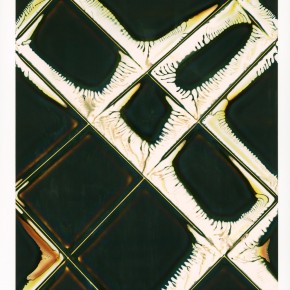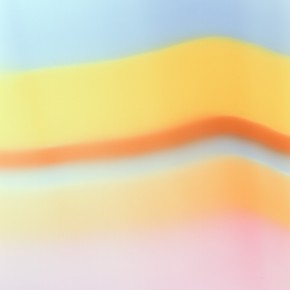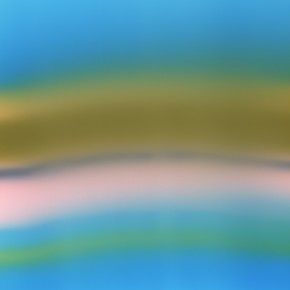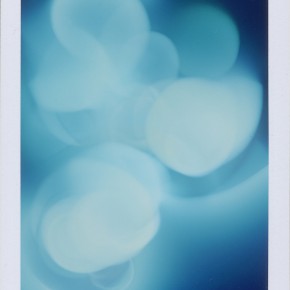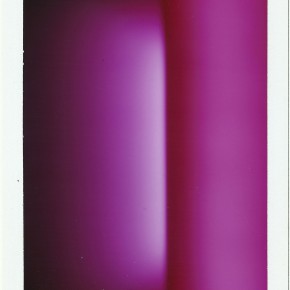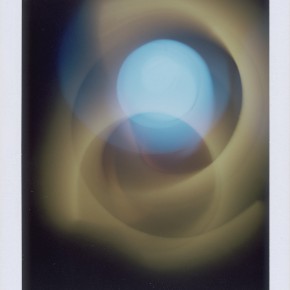
Artist Statement
Fluorescent paper and photographic film, the former absorbs and emits light, while under chemical reaction, the other will retain its reflection once in contact with light. How does the two different light sensitive material leave an impression on the film through various experiments and variables? As each and every second of the production process and millimetres in distance produces varying results. I am painting with light, through photography.
The Gift from Jiang Pengyi, The Explorer of Light
By Gu Zheng
In Dark Addiction series, Jiang Pengyi puts the nature creatures, the fireflies, into a box with photographic film inside. As the fireflies keep moving and giving out faint light in the box for a long time, the luminous trace left when they move are recorded by the emulsion on the film, which then reveals themselves as photos, lightboxes after being developed and printed.
In some sense, Jiang Pengyi is one of the few Chinese contemporary artists who take the nature and the representation of light as their main concern. How does light live in time? How to show the existence of light? In what form can light be presented? These questions about the essence of light are explored by the intersection and synaesthesia between nature and culture, which is revealed by the fireflies and photographic light-sensitive material in this series. Time becomes an important medium during the exploration. Every film that appeared as photos at last is the drawing board as well as the container of time. With time as an intermediary, the light transforms into a kind of material object optically and chemically. By endowing light with time, Jiang Pengyi suggests the visual presentation of light in the dimension of time.
Another exhibited series called Intimacy is a story, or an allegory, about light as well. Jiang Pengyi makes the fluorescent paper, absorbing and giving out light, and the light-sensitive photographic film that saves the light by silver salt encounter and reflect with each other, and in such a touch-like way, the film obtains the light from another object and sense it. After doing so, the abstract wire-colored photos are released by the sensitized film. It’s a practice of painting light by the reflection of objects, which is based on the hypnosis that the film could be thoroughly sensed the light, and on this basis, the film slowly absorbs the luminous energy, transfers it into a part of itself, and develops. The result of developing, in fact, is a new state, or shape, of light by a kind of photosynthesis carried out by the photosensitive character of both. Fundamentally, it’s an optical process about encounter, absorption, acceptance, and inclusion, and also an affective process how an artist comprehends, reveals, and communicates with light.
From the historic perspective of photography, Rayogram, or Photogram, invented in the first half of 20 century by Man Ray and Moholy-Nagy is a photographic technique that saves the shadow of the various objects stand still under the illuminant by instant exposure. The emphasis of such an imaging process is how to get the appropriate exposure fast but not industriously, in which time only help film to expose as quickly as possible, although it’s an unavoidable factor of it. Oppositely, Jiang Pengyi extends the time deliberately and makes it an influencing factor that allows dim light into its full play of a light pen, which leads to several, even dozens of hours of sensitization becoming the basic requirement for the result he chases, and in which perspective, such long-time exposure is a development of Photogram that time occupies an important position during the course of imaging. However, the conception as well as method of Photogram that produces images without camera is an anti-photographic practice, which objects to the photographic vision and writing based on the perspective and negates the necessity of the camera. In this view, both the Dark Addiction and Intimacy possess such quality.
Those two series of works echo with the Theaters of Hiroshi Sugimoto, because both of them take the photographic plate as a container of time that leaves enough space for light to accumulate energy and eventually present some unique shape, hence endows depth to the flat plate owing to the effects of light. Light, in his hands, becomes a means to make invisible but sensible three-dimensional space on the two-dimensional plate.
Certainly, it isn’t persuasive to discuss Jiang Pengyi’s work only in the light of photography history. His works, essentially, is a visualization of an allegory of life.
The numerous overlaid light traces in Dark Addiction surely remind us of the mystery forest in summer night, and also the touching scene of the fireflies flying and dancing in the air. Such beautiful memory is presented in an aesthetic way in the first place. Isn’t the crossing traces knitted by the weak little insects a portrayal of the life courses of most people? In some certain time and space, doesn’t uncountable people’s life entangled with each other disorderly but fatefully like this? Isn’t the interlacing of light and shadow a reflection of our states? However, what the Intimacy indicates is how things shine with, accept and tolerate each other, and, additionally, the possibility of new vital energy. Those two series, radically, is a writing of light that were given out by tiny objects, and a light-based discussion about the significance of life.
I believe that either the Dark Addiction or the Intimacy is a fascination of light, only the one who is sensitive of light as well as life could invent such colorful narration and allegory of light. It’s a special gift from Jiang Pengyi, the explorer of light, inquiring how light is what it is.
Translator: Ariane, Luan Zhichao 2014-05-08
About the exhibition
Dates: Mar-28, 2015 - May-17, 2015
Venue: ShanghART Singapore
Address: 9 Lock Road, #02-22, Gillman Barracks, Singapore 108937
Courtesy of the artist and ShanghART Singapore, for further information please visit www.shanghartgallery.com.




